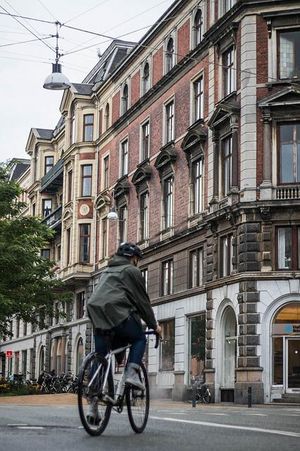Urban cycling traffic management (Copenhagen, Denmark)

Area: urban
Date implemented: Some of the elements, such as the Green Waves and CyKap systems, were deployed relatively rapidly throughout 2013 to 2015. Others, such as the traffic management system (2013–2018) and the COMPASS model (2016–2022) took longer to conceive, develop and deploy. All systems are fully or partially operational today
How long from concept to implementation: Budgetary processes are slow, as are the development of EU funding proposals, so the initial concept was developed more than a year before the projects could start, followed by market investigation, project pathfinding, partner clarification, and specification phases, which can easily take a year. Then the deployment can take one to two additional years.
Relation between efforts undertaken and benefits achieved: Projects are undertaken based on promised or expected benefits with respect to improved services and conditions for road users and citizens in Copenhagen. A project might not always achieve this goal directly or, worst case, might fail in its purpose, while still providing benefits such as increased knowledge and insight into the feasibility of a solution or technology. The calculation of the relationship between effort and benefits is therefore always hard in innovation and development projects. But it is important for all private actors and public authorities to undertake these projects regardless, as there is always learning and insight and mostly real experienced benefits for the road users and citizens.
What was done and how: The first stage was to encourage the market in creating and offering standard traffic management, ITS and C-ITS solutions for cyclists. Secondly, when the market did not have adequate solutions ready, the City of Copenhagen attempted to create custom and innovative solutions for the needs in the city.
Why it worked to 'fast track' the innovation/measure: Cycling is the transport mode of the future, and it is important to encourage the market to see this. Cities like Copenhagen are firstly ensuring they are accomodating this, and later implementing ready solutions, alongside other cities with similar ambitions, to increase the adoption of solutions with improved conditions for their cyclists, road users and citizens as a result.
Lessons learnt: Sometimes the technologies are mature, but the suppliers providing them are less so. The market is still to some degree dominated by an outdated logic that competitions and not cooperation is the way to secure the most profits. Some are still focused on their piece of the cake, instead of contributing to the whole cake.
Tips for replication: Use real open standards and open source systems. Off the shelf hardware is preferable. Make sure ownership of the system is yours to the largest degree possible. Be very aware of vendor lock in and black boxed systems.
Date implemented: Some of the elements, such as the Green Waves and CyKap systems, were deployed relatively rapidly throughout 2013 to 2015. Others, such as the traffic management system (2013–2018) and the COMPASS model (2016–2022) took longer to conceive, develop and deploy. All systems are fully or partially operational today
How long from concept to implementation: Budgetary processes are slow, as are the development of EU funding proposals, so the initial concept was developed more than a year before the projects could start, followed by market investigation, project pathfinding, partner clarification, and specification phases, which can easily take a year. Then the deployment can take one to two additional years.
Relation between efforts undertaken and benefits achieved: Projects are undertaken based on promised or expected benefits with respect to improved services and conditions for road users and citizens in Copenhagen. A project might not always achieve this goal directly or, worst case, might fail in its purpose, while still providing benefits such as increased knowledge and insight into the feasibility of a solution or technology. The calculation of the relationship between effort and benefits is therefore always hard in innovation and development projects. But it is important for all private actors and public authorities to undertake these projects regardless, as there is always learning and insight and mostly real experienced benefits for the road users and citizens.
What was done and how: The first stage was to encourage the market in creating and offering standard traffic management, ITS and C-ITS solutions for cyclists. Secondly, when the market did not have adequate solutions ready, the City of Copenhagen attempted to create custom and innovative solutions for the needs in the city.
Why it worked to 'fast track' the innovation/measure: Cycling is the transport mode of the future, and it is important to encourage the market to see this. Cities like Copenhagen are firstly ensuring they are accomodating this, and later implementing ready solutions, alongside other cities with similar ambitions, to increase the adoption of solutions with improved conditions for their cyclists, road users and citizens as a result.
Lessons learnt: Sometimes the technologies are mature, but the suppliers providing them are less so. The market is still to some degree dominated by an outdated logic that competitions and not cooperation is the way to secure the most profits. Some are still focused on their piece of the cake, instead of contributing to the whole cake.
Tips for replication: Use real open standards and open source systems. Off the shelf hardware is preferable. Make sure ownership of the system is yours to the largest degree possible. Be very aware of vendor lock in and black boxed systems.






